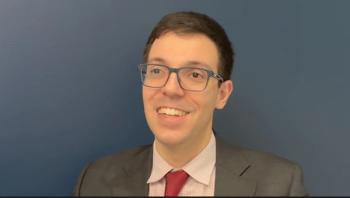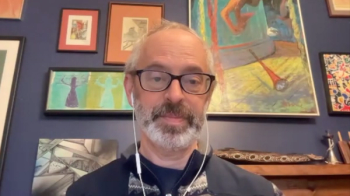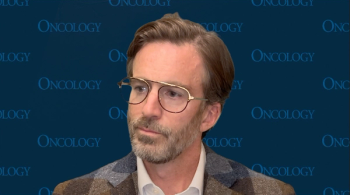
- ONCOLOGY Vol 39, Issue 5
- Volume 39
- Issue 5
- Pages: 212-213
Maximizing Safe Resection in High-Grade Gliomas
Jennifer Moliterno, MD, FAANS, discusses current neurosurgical strategies for newly diagnosed high-grade gliomas.
For clinicians managing patients with newly diagnosed high-grade gliomas, the neurosurgical approach is a critical determinant of both survival and quality of life. Maximizing the safety of resection while diligently preserving neurological function stands as a paramount goal.
Jennifer Moliterno, MD, FAANS, chief of neurosurgical oncology; clinical director of the Chênevert Family Brain Tumor Center; director of the Susan Beris, MD Neurosurgical Oncology Program; surgical director of the Facial Pain and Spasm Program; and director of Neurosurgical Oncology Fellowship, Neurosurgical Oncology at Yale School of Medicine, spoke with CancerNetwork® about this complex landscape.
The conversation detailed how advanced tools are integrated into surgical planning and execution. She shed light on the indications and implementation of awake craniotomy, a sophisticated technique that allows for real-time functional monitoring in eloquent brain regions. Furthermore, she discussed the utility of sleep mapping in specific tumor locations, highlighting the tailored approaches necessary to address the diverse anatomical and functional considerations presented by high-grade gliomas.
CancerNetwork: For newly diagnosed high-grade gliomas, what are the current neurosurgical strategies to maximize safe resection while preserving neurological function, and how do you integrate intraoperative imaging and mapping techniques to achieve this?
Moliterno: With high-grade gliomas, it is our goal to resect as much of the tumor as safely as possible. It has shown a survival benefit. In addition to that, we can also improve neurological function with surgery; that can be another goal as well. Some of the ways we do that depend on the location of the tumor. For instance, if the tumor is in an eloquent location of the brain, such as one that involves language or motor skills, we might keep the patient awake during surgery. We’ll start out with the patient asleep and make sure they’re comfortable, wake them up, keep them comfortable, and have them talk to us. There is sophisticated testing by neurophysiologists, or if it’s for motor skills, we’ll have them move whatever extremity is appropriate for what we’re testing. Then, we can stimulate and map the brain to see where the function is relative to the tumor. There’s nothing better than having the patient awake in the sense that we get real-time feedback if we expect there to be any issue or any problem. Not every person needs to be kept awake, and there can be some barriers for patients. Certain patients can have more anxiety than others, understandably. We can also do sleep mapping when we need to, and that is more commonly used in tumors that are in, near, and around what we call the eloquent brain [location], which has significant function. When patients are asleep, we can do what we call subcortical mapping or stimulation, where as we get deeper down into the brain and we are cognizant and aware of some of the motor fibers, for instance—not the motor cortex, but the fibers—we can stimulate those as well.
In the management of brain metastases, what are the key factors that guide the decision between surgical resection, stereotactic radiosurgery, and systemic therapy alone, particularly in the context of oligometastatic disease?
That’s an evolving field. Certainly, with metastatic tumors, more types of treatment can be used in their armamentarium than for primary brain tumors. For instance, a lot can depend on the origin of the metastatic tumor. If it’s lung vs renal vs breast [cancer], for instance, or melanoma, there can be different systemic therapies that might even work with the brain metastases as well. Oftentimes, radiosurgery can be used for brain metastases. Laser interstitial therapy and thermal coagulation can be used for brain metastases. There are other options in terms of radiation and systemic treatment that can correlate with the underlying cancer type and can be used for metastatic disease, whereas primary brain tumors are more focused on the role of surgery up front, followed by the standard treatment of radiation and chemotherapy, along with clinical trials.
How has the integration of molecular diagnostics, such as IDH and MGMT status, influenced surgical planning and the extent of resection in diffuse gliomas?
Currently, there’s a lot of work and research being done about trying to understand or predict those mutations ahead of time. For IDH [mutations], there has been some more success with trying to predict that ahead of time based on the MRI and certain characteristics, [like] the age of the patient, that can be taken into consideration. For IDH-mutated tumors, we typically will try to remove the nonenhancing portion of the tumor as a general rule, whereas with IDH wild-type tumors, we focus on removing the area that takes up the dye or the contrast-enhanced area; it can differ. There are certain factors based on the MRI that can allow us to think that we might be dealing with an IDH-mutated tumor vs the patient’s age and some other factors.
Your faculty page highlighted that you typically see patients looking for second or third opinions on their treatment plans. Is there anything specific you offer that clinicians in different parts of the country may not?
What I always say to patients—and it’s the truth—is that there’s a number of us who are highly subspecialized in brain tumor surgery from a neurosurgical perspective. It does make a difference in terms of seeking out one of those specialists for brain tumor surgery. It can make the difference between undergoing a biopsy or a subtotal resection of the tumor vs a gross total resection of the tumor, and with gliomas, that can have an impact on survival.
Oftentimes, I can see patients who might have had a smaller surgery done elsewhere by another neurosurgeon. [Alternatively], some people tend to look around between various specialists, such as myself, trying to compare one with the other. Typically, if you’re dealing with the subset of specialists and experts like me, we usually have very comparable rates in terms of our ability to remove the tumor and to have good outcomes. There can be a variable difference between those people who specialize in brain tumor surgeries vs those who are more general neurosurgeons. I always encourage patients to ask about numbers and volume in terms of how many brain tumor surgeries they perform each year because those things do impact the type of surgery that the patient’s going to get.
How do you collaborate with medical and radiation oncologists to optimize the timing and sequencing of surgery, radiation therapy, and systemic therapies for different types of brain tumors?
One of the unique things about us, in addition to our expertise for maximizing and safely improving the extent of resection, is that all our tumors undergo what we call whole-exome sequencing so we can understand the tumor from a molecular genetic perspective. We’re unique with that comprehensive next-generation sequencing technique that we do for all our patients who have surgery here. We can then use that information in our multidisciplinary group. I lead the multidisciplinary brain tumor board as well as the precision brain tumor board, where, after surgery, we can then use those molecular data for each person to personalize more precise treatment. A lot of times, there’s the standard of care for glioma; for instance, with radiation and with chemotherapy. Sometimes, there can be opportunities for more personalized treatment. That’s where we then coordinate with our neuro-oncologists and our radiation oncologists. We do have a seamless team that allows us to then transition the patient’s care from the surgeon to the neuro-oncologist and medical doctor as the quarterback for the patient. Then [we can] incorporate the radiation doctors as well.
What are the common neurological complications following brain tumor surgery, and what strategies are used for their prevention and management in the immediate and long term?
The honest answer is it’s unique to each patient. As I always say to patients, there are standard risks of surgery, and so bleeding and infection are standard risks of any type of surgery in general and certainly with brain tumor surgery. What I will then tell patients is how their risk of surgery is tailored and that a lot of times, it depends on the location of the tumor, how infiltrative the tumor is, the behavior of the tumor, and whether that tumor involves critical neurovascular structures, such as arteries. [With] bigger arteries, I am very used to working around and protecting them. Sometimes, even with my expertise and experience, the smaller arteries can get a little trickier because they can be embedded in the tumor. They can supply the tumor but also supply the brain, which can lead to postoperative issues such as weakness or a new neurological deficit.
Recurrent surgery is a different consideration in and of itself. Sometimes, patients will have multiple surgeries for progression or recurrence of disease. Each time we operate, the risk can be a bit higher for potential issues or complications. I always say it’s not so much having to relate to the surgery itself; the brain is different. The person’s brain has been through more: the radiation effects, the growth of the tumor, and the effects of the brain being sick for so long due to the tumor. [Regarding] those things, even I have found surgeries can go perfectly well from a technical standpoint, but we can still encounter issues postoperatively. That could be a little hard for someone’s brain to recover [from] the more they are in treatment. That usually reflects being on treatment for longer.
Articles in this issue
Newsletter
Stay up to date on recent advances in the multidisciplinary approach to cancer.



















































































